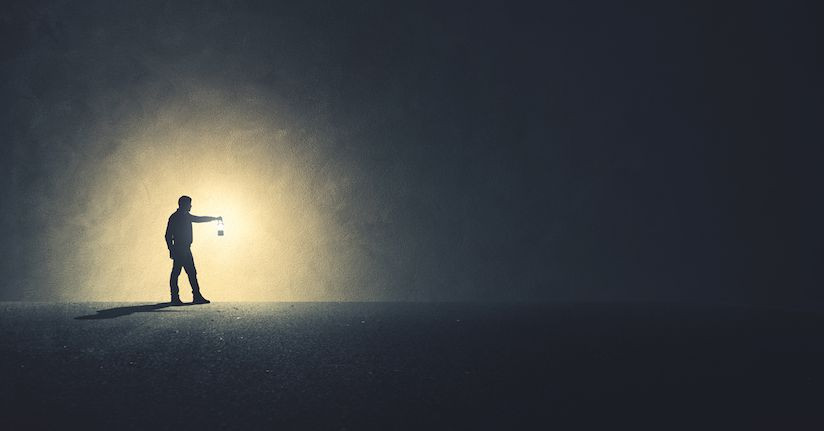Light Sensitivity at Night: Here’s How It Can Happen
It sounds like an oxymoron: light sensitivity at night. How can you experience this kind of strong sensitivity when there is (mostly) an absence of light? Believe it or not, you actually can have this painful symptom during the evening hours, and we highlight a few of the ways that light sensitivity can be aggravated at this time.
Bright Car Headlights
Perhaps the biggest offender when it comes to nighttime photophobia is car headlights. Again and again, patients describe the horror of bright LED lights shining directly in their eyes while on the road at night. Janet describes it this way:
"The vast contrast between the darkness that had enveloped me and this sudden, jarring brightness is too much for my brain to compute...this bright visual stimulation is one of my most frustrating migraine triggers, and I often worry that driving at night on dark roads will end up putting me in migraine mode."
She hit the proverbial nail on the head. The contrast from deep darkness to blinding light has often been associated with light-sensitive conditions, especially migraine. The brain becomes agitated, and as a result, an attack can be initiated. Studies have supported this finding as well, showing that vehicle lights can bring on hallmark light sensitivity symptoms such as glare, visual discomfort and ocular blurriness. It only gets worse for people who are prone to headache or migraine attacks due to light.1 There is also evidence that it affects older drivers more prominently as well.2
Polar Night and Day
Locations that feature extreme periods of darkness and light—known as polar night and day, respectively—can really mess with a person’s brain chemistry. For people who have headaches that are not migraine attacks, the darker season in some parts of Alaska, Norway and other places is more likely to worsen their symptoms. Even for those with migraine, about 10% have headache pain, light sensitivity and related issues during this extended night phase; those with migraine aura photophobia may be particularly vulnerable for seasonal complications.3 This type of turbulent lighting also creates problems during the “transition” period from day to night. Many cite sunrise and dusk as triggering factors for their sensitivities.
A number of reasons may contribute to this effect, from melatonin production or suppression to disrupted circadian rhythms and sleeping patterns, both of which can affect the underlying condition and therefore any photophobic reactions it produces. The dark adaptation process also likely plays a critical role in this process. Our eyes and brain eventually become accustomed to this prolonged exposure to darkness, such that taking in just a little bit of light thereafter (even if it's not super bright) can trigger a painful response. For this reason, so many with light sensitivity seek solace in completely darkened rooms. It also further explains why polar day season can be particularly brutal with the strong density of sunlight, especially on the heels of an extended “nighttime” period.
Blue Light at Night
Many experts believe that artificial blue light can greatly affect how we feel. Our exposure to artificial light at night—through our computer screens or digital devices—can negatively influence our sleep as well as our alertness and concentration the next day. Blue wavelengths can be even more detrimental for those with light sensitivity due to a chronic condition. While we all have naturally-photosensitive cells in our eyes that are activated from these wavelengths, chronic neurological dysfunction can make any light-induced pain feel worse.
In fact, research has shown that screen time is already associated with greater risk for the onset of migraines and other symptoms. And bright device lighting specifically in a dark environment can lead to straining of the eyes after just twenty minutes!4 This of course can make us more sensitive to light and more prone to painful smartphone-triggered headaches too.
Interictal Light Sensitivity
For those with a chronically light-sensitive disorder, light is often painful even outside of attacks or symptomatic episodes. For example, when a migraine ends, many of the physical symptoms dissipate; but a postdrome or post-attack period can set in, during which some issues may linger and/or new ones develop. Heightened sensitivity to light is a complaint for many during this time.5 So if you are coming out of an attack during the evening, even a small amount of dim light (such as from a night light or street light) can be enough to cause light sensitive pain.
This indicates that the central nervous system remains highly sensitized, outlasting even the core migraine or photophobic episode. In addition, those with these conditions generally have a lower acceptance level for the brightness of light, which may further explain ongoing discomfort. And the effects of dark adaptation, either through perpetually hiding in dark rooms or wearing sunglasses indoors, also can make a person experience increased photophobia all the time.
References:
1Salvaia J, Elias J, Shepherd AJ. Symptoms of visual discomfort from automobile lights and their correlation with headache in night-time taxi drivers. Lighting Research & Technology. 46(3):354–363.
2Mainster MA, Timberlake GT. Why HID headlights bother older drivers. Br J Ophthalmol. 2003;87(1):113–117. doi:10.1136/bjo.87.1.113
3Lilleng H, Bekkelund SI. Arctic environment triggers migraine attacks. Can Fam Physician. 2010;56(6):549–551.
4Montagni I, Guichard E, Carpenet C, Tzourio C, Kurth T. Screen time exposure and reporting of headaches in young adults: A cross-sectional study. Cephalalgia. 2016 Oct;36(11):1020-1027. doi: 10.1177/0333102415620286. Epub 2016 Jul 19.
5Hayne DP, Martin PR. Relating Photophobia, Visual Aura, and Visual Triggers of Headache and Migraine. Headache. 2019 Mar;59(3):430-442. doi: 10.1111/head.13486. Epub 2019 Feb 8.

TheraSpecs® Glasses for Light Sensitivity
Find the glasses that fit your needs and lifestyle, and stay protected from screens, fluorescents, unwanted blue light, sunlight, flashing lights, and more.
Shop Now



